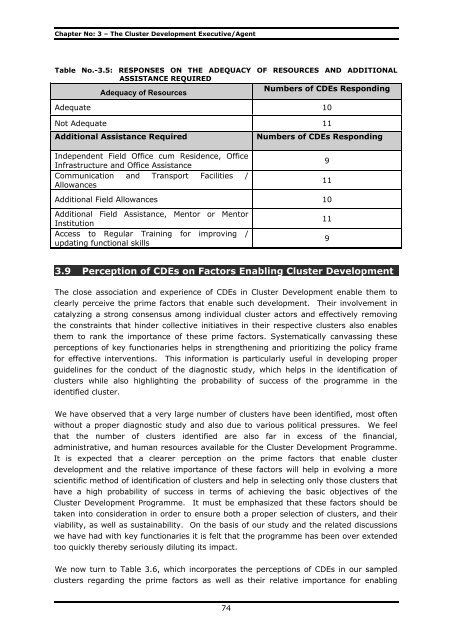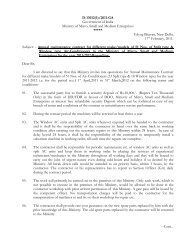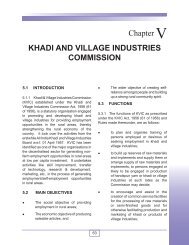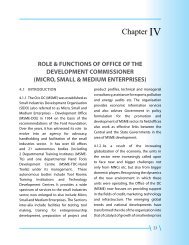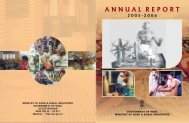Evaluation Study MSE Cluster Development - Ministry of Micro ...
Evaluation Study MSE Cluster Development - Ministry of Micro ...
Evaluation Study MSE Cluster Development - Ministry of Micro ...
Create successful ePaper yourself
Turn your PDF publications into a flip-book with our unique Google optimized e-Paper software.
Chapter No: 3 – The <strong>Cluster</strong> <strong>Development</strong> Executive/AgentTable No.-3.5: RESPONSES ON THE ADEQUACY OF RESOURCES AND ADDITIONALASSISTANCE REQUIREDNumbers <strong>of</strong> CDEs RespondingAdequacy <strong>of</strong> ResourcesAdequate 10Not Adequate 11Additional Assistance RequiredIndependent Field Office cum Residence, OfficeInfrastructure and Office AssistanceCommunication and Transport Facilities /AllowancesNumbers <strong>of</strong> CDEs RespondingAdditional Field Allowances 10Additional Field Assistance, Mentor or MentorInstitutionAccess to Regular Training for improving /updating functional skills9111193.9 Perception <strong>of</strong> CDEs on Factors Enabling <strong>Cluster</strong> <strong>Development</strong>The close association and experience <strong>of</strong> CDEs in <strong>Cluster</strong> <strong>Development</strong> enable them toclearly perceive the prime factors that enable such development. Their involvement incatalyzing a strong consensus among individual cluster actors and effectively removingthe constraints that hinder collective initiatives in their respective clusters also enablesthem to rank the importance <strong>of</strong> these prime factors. Systematically canvassing theseperceptions <strong>of</strong> key functionaries helps in strengthening and prioritizing the policy framefor effective interventions. This information is particularly useful in developing properguidelines for the conduct <strong>of</strong> the diagnostic study, which helps in the identification <strong>of</strong>clusters while also highlighting the probability <strong>of</strong> success <strong>of</strong> the programme in theidentified cluster.We have observed that a very large number <strong>of</strong> clusters have been identified, most <strong>of</strong>tenwithout a proper diagnostic study and also due to various political pressures. We feelthat the number <strong>of</strong> clusters identified are also far in excess <strong>of</strong> the financial,administrative, and human resources available for the <strong>Cluster</strong> <strong>Development</strong> Programme.It is expected that a clearer perception on the prime factors that enable clusterdevelopment and the relative importance <strong>of</strong> these factors will help in evolving a morescientific method <strong>of</strong> identification <strong>of</strong> clusters and help in selecting only those clusters thathave a high probability <strong>of</strong> success in terms <strong>of</strong> achieving the basic objectives <strong>of</strong> the<strong>Cluster</strong> <strong>Development</strong> Programme. It must be emphasized that these factors should betaken into consideration in order to ensure both a proper selection <strong>of</strong> clusters, and theirviability, as well as sustainability. On the basis <strong>of</strong> our study and the related discussionswe have had with key functionaries it is felt that the programme has been over extendedtoo quickly thereby seriously diluting its impact.We now turn to Table 3.6, which incorporates the perceptions <strong>of</strong> CDEs in our sampledclusters regarding the prime factors as well as their relative importance for enabling74


